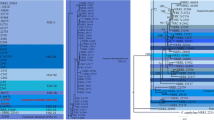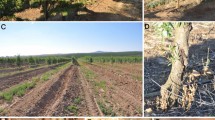Abstract
Scanning electron microscopy has shown thatFusarium nivale Ces. ex Sacc., the anamorph ofMonographella nivalis (Schaffnit) E. Müll., has annellate conidiogenous cells and this character together with its amphisphaeriaceous teleomorph distinguishes it from other fusaria.F. nivale and its varietymajus are assigned to a new genus,Gerlachia, asG. nivalis var.nivalis andG. nivalis var.major. For the teleomorph of the latter the new combinationMonographella nivalis var.neglecta (Krampe) W. Gams & E. Müll. is proposed. The causal agent of rice leaf scald,Rhynchosporium oryzae Hashioka & Yokogi, has the same conidiogenesis and is transferred toGerlachia asG. oryzae (Hashioka & Yokogi) W. Gams and distinguished fromG. nivalis by conidial shape and higher cardinal temperatures.
Samenvatting
Door middel van scanning elektronenmicroscopie werd aangetoond datFusarium nivale Ces. ex Sacc., de imperfecte vorm vanMonographella nivalis (Schaffnit) E. Müll., geringde conidiogene cellen bezit. Door dit kenmerk en de tot de Amphisphaeriaceae horende perfecte vorm wijkt de soort van de overigeFusarium-soorten af. Deze soort en de variëteitmajus worden in een nieuw geslacht,Gerlachia, geplaatst alsG. nivalis var.nivalis andG. nivalis var.major. Voor de perfecte vorm van deze laatste wordt de nieuwe combinatieMonographella nivalis var.neglecta (Krampe) W. Gams & E. Müll. geïntroduceerd. De verwekker van een bladschroeiziekte bij rijst,Rhynchosporium oryzae Hashioka & Yokogi, heeft dezelfde soort van conidiënvorming en wordt naarGerlachia overgebracht alsG. oryzae (Hashioka & Yokogi) W. Gams. Deze soort is te onderscheiden vanG. nivalis door de conidiënvorm en temperatuureis voor groei.
Similar content being viewed by others
References
Årsvoll, K., 1975. Fungi causing winter damage on cultivated grasses in Norway. Meld. Norg. LandbrHøgsk. 54(9): 49 pp.
Boerema, G. H. & Verhoeven, A. A., 1977. Check-list for scientific names of common parasitic fungi. Series 2b: Fungi on field crops; cereals and grasses. Neth. J. Pl. Path. 83: 165–204.
Cole, G. T. & Samson, R. A., 1979. Patterns of development in conidial fungi. Pitman, London: 190 pp.
Colhoun, J., 1970. Epidemiology of seed-borneFusarium diseases of cereals. Annals Acad. Sci. fenn., Ser. A, IV, 168: 31–36.
Duben, J., 1978. Untersuchungen zum Fusskrankheitskomplex an Winterweizen unter besonderer Berücksichtigung von Arten der GattungFusarium Lk. Diss. Univ. Göttingen: 149 pp.
Hammill, T. M., 1973. Fine structure of annellophores. IV.Spilocaea pomi. Trans. Br. mycol. Soc. 60: 65–68.
Hammill, T. M., 1974. Electron microscopy of phialides and conidiogenesis inTrichoderma saturnisporum. Am. J. Bot. 61: 15–24.
Hashioka, Y. & Ikegami, H., 1955. The leaf scald of rice. Jubilee publication in commemoration of the sixtieth birthdays of Prof. Yoshihito Tochinai and Prof. Teikichi Fukushi. Contr. Lab. Pl. Dis. Sci., Fac. Agric., Gifu Univ. 6: 45–51.
Hennebert, G. L. & Weresub, L. K., 1977. Terms for states and forms of fungi, their names and types. Mycotaxon 6: 207–211.
Hughes, S. J., 1953. Conidiophores, conidia, and classification. Can. J. Bot. 31: 577–659.
Jamalainen, E. A., 1974. Resistance of winter cereals and grasses to low-temperature parasitic fungi. A Rev. Phytopath. 12: 281–302.
Kendrick, B. (Ed.), 1979. The whole fungus. National Museum of Natural Sciences, Ottawa. 2 vols, 793 pp.
Müller, E., 1977. Die systematische Stellung des ‘Schneeschimmels’. Revue Mycol. 41: 129–134.
Naito, H. & Koshimizu, Y., 1974. Morphology and hyphal growth temperature of brown leaf spot fungus of rice (Rice scald fungus). Ann. phytopath. Soc. Japan 40: 319–328.
Ou, S. H., 1972. Rice diseases. Commonwealth Mycological Institute, Kew: 368 pp.
Owen, H., 1973.Rhynchosporium secalis. CMI Descr. pathog. Fungi Bact. No. 387.
Parkinson, V. O., 1979. Cultural characteristics of the rice leaf scald fungus.Rhynchosporium oryzae. Trans. Br. mycol. Soc. (in press).
Petrini, O., Müller, E. & Luginbühl, M., 1979. Pilze als Endophyten von grünen Pflanzen. Naturwissenschaften 66: 262.
Samson, R. A., Stalpers, J. A. & Verkerke, W., 1979. A simplified technique to prepare fungal specimens for scanning electron microscopy. Cytobios 24: 7–12.
Smith, J. D., 1978.Fusarium nivale from cereals and grasses: Is it the same fungus? Preprint from Fusarium Newsletter.
Subramanian, C. V. & Bhat, D. J., 1978. Developmental morphology of Ascomycetes. III.Monographella nivalis. Revue Mycol. 42: 293–304 and 43: 218 (1979).
Tuyl, J. M. van, 1978. Genetics of fungal resistance to systemic fungicides. Meded. LandbHogesch. Wageningen 77(2): 136 pp.
Zambettakis, C., 1950. Une fusariose du panicle du riz en Oubangui. Revue Mycol. 15, Suppl. colon. 2: 106–111.
Author information
Authors and Affiliations
Rights and permissions
About this article
Cite this article
Gams, W., Müller, E. Conidiogenesis of Fusarium nivale and Rhynchosporium oryzae and its taxonomic implications. Netherlands Journal of Plant Pathology 86, 45–53 (1980). https://doi.org/10.1007/BF02650394
Accepted:
Issue Date:
DOI: https://doi.org/10.1007/BF02650394




